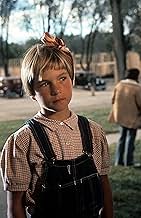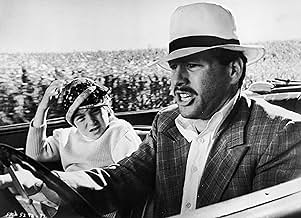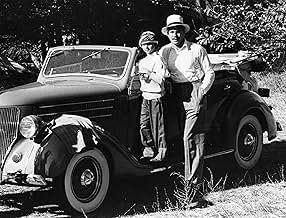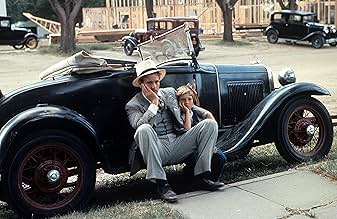Durante a Grande Depressão, um golpista cuida de uma jovem que pode ou não ser sua filha, mas os dois criam um relacionamento improvável.Durante a Grande Depressão, um golpista cuida de uma jovem que pode ou não ser sua filha, mas os dois criam um relacionamento improvável.Durante a Grande Depressão, um golpista cuida de uma jovem que pode ou não ser sua filha, mas os dois criam um relacionamento improvável.
- Direção
- Roteiristas
- Artistas
- Ganhou 1 Oscar
- 9 vitórias e 10 indicações no total
- The Minister
- (as Jim Harrell)
- Direção
- Roteiristas
- Elenco e equipe completos
- Produção, bilheteria e muito mais no IMDbPro
Avaliações em destaque
In the time of the Great Depression, a little girl named Addie (Tatum) is left abandoned by the death of her mother, a woman who hung around in bars and left Addie with a big mystery as far as the identity of her father is concerned. At her gravesite, a dodgy stranger named Moses (Ryan O'Neal) happens by to pay his respects, and is immediately recruited by the other mourners, who don't want to be burdened with the girl, with the assignment of delivering Addie to her next-of-kin.
"God works in mysterious ways," one of the mourners says, after Moses reluctantly accepts.
"Don't He now?" Moses replies.
God indeed may have some unfinished business with Moses Pray, a conman who uses the Good Book as his device for fleecing newly-made widows of a few bucks. Watching the O'Neals work their family chemistry for sparks and laughs while Moses, with unexpected help from Addie, works his scams, is great fun. A lingering question is whether Moses and Addie are in fact related; many in the movie point out their similar jawlines, but Moses refuses to accept the idea. Addie is more open to it. Clearly Moses for all his faults fills a hole in her life.
There was a time when Peter Bogdanovich could do no wrong as a director; here he presents us with an assured callback to 1930s- period sensibilities by employing a flat Kansas landscape and scenic design that suggests a combination of Norman Rockwell and Grant Wood, at once homey and vaguely grotesque. The story moves fast, the dialogue is crisp and believable, and the O'Neals' performances of such strong quality as to make you wonder why they so seldom impressed in other roles. The talent is there on the screen.
Tatum was the real surprise here; decades later, long after the flash of her career faded, it's hard not to be as bowled over by what she gives you as all those critics and movie-goers were so long ago. Avoiding the cutesiness of child actors, she plays her character as sharp-tongued and vinegary, with a hint of real beauty beneath the smudges. "Ain't she got a sweet little face, somehow," is the best anyone can manage in the way of compliments, but Addie don't need them. She just wants her 200 dollars, or "two hundra DOLLA" as she keeps putting it to Moses.
The two of them make such a pair I get annoyed when Madeline Kahn joins them for a time as a conniving, cheapjack vixen named Trixie. Unlike the O'Neals, Kahn is an actress I usually enjoy in anything, so why is she so duff to me here? Trixie is a one-note performance that grates on me; I can't wait for the Prays to leave her in their dust.
I did enjoy P. J. Johnson as Trixie's put-upon maid, Imogene. She adds some heart and gives Addie some company for some of the movie's best scenes. So too does a raft of supporting players, most of whom like Kahn must have been waiting for Mel Brooks' call-backs for "Blazing Saddles" at the time of this production.
Mostly, though, this is Tatum's film; it rises or falls with her and, as a result of her spry performance, rises quite impressively. Bogdanovich clearly gambled putting his promising career on her little shoulders; unlike later gambles of his this paid off spectacularly and yields dividends to this day.
The plot is OK. The setting/location/cinematography is OK. I liked Ryan O'Neal in Love Story and What's Up Doc. He's good enough here.
But, this movie is a 10 for one, and only one, reason. Ten year old Tatum O'Neal is impossible to take your eyes off of the entire movie. I challenge anyone to name a better performance by an actress/actor in a movie than this one by Ms. O'Neal.
What a joke she won the Oscar for Best Supporting Actress because the Academy didn't think a ten year old should win the Best Actress award.
She's on screen only about 95% of the time.
I love what Madeline Kahn says about that. MK says she - MK- should have won Best Supporting Actress. Tatum should have won Best Actress.
Shot completely on locations in Kansas and Missouri PAPER MOON sparkles with a richness only capable in black and white. Cinematographer Lazlo Kovacs is a great camera artist and never better than PAPER MOON where he uses black and white, deep focus and those great long takes to its best advantage. To the untrained eye it will just appear very sharp, but look closely at each frame and notice that everything is in tack sharp focus from the closest object to far in the distance. This deep focus is very difficult to achieve correctly, especially in the night shots, but Kovacs does it so well it is seamless. Watch for the train station sequence where even the children playing in the background are razor sharp. This is a look that can only be achieved using black and white to its fullest potential. New filmmakers take notice. This is how it's supposed to be done. All this cinematic brilliance would be wasted were it not for the wonderful direction of Bogdanovich. In this his third film, he proves that he is a consummate filmmaker who knows how to move the actors and camera in perfect concert. His craftsmanship of each scene is unmistakable as he brings a fresh and very new approach using Hollywood tricks which are decades old. A lesser director might have used process shots and sets to tell the story, but not Bogdanovich. He shot the entire film in real locations to give it the look and feel of a real thirties road picture. You can almost smell the wide plains and feel the dust as it comes up to slap you in the face. Notice too how he never resorts to sentimentality to move the story along, it is told razor sharp and without tears. This, never more apparent than the final sequence where he pays off the film in grand style.
There is only one thing about this film which still baffles me. Why in the night time hotel sequence toward the end of the film were electric lights everywhere but inside the hotel lobby, which was lit entirely with kerosine lamps? Was it to give the look and feel of the period, or did the real location use them? Small point, but interesting. If, like myself, the last time you saw PAPER MOON was when it was released in 1973, see it again on DVD and be delighted all over again. The DVD transfer is marvelous and only serves to heighten its visual appeal. If you have only seen PAPER MOON on broadcast TV, do yourself a favor and see the new DVD for a pleasant surprise. Without the obligatory broadcast TV commercials, pan and scan and dialogue cuts this will appear like a new film seen the way it was supposed to be seen. And if you have NEVER seen PAPER MOON and harbor some prejudice against black and white films, please see this film. Any preconceived notions against this format will quickly dissolve as it takes you along for a rich ride with Addie and Moze in the only format it could - glorious black and white.
Você sabia?
- CuriosidadesTatum O'Neal was ten years old when she won the Academy Award for Best Supporting Actress for her performance in this movie, making her the youngest person ever to win an Oscar in a competitive category. As of 2023, she still holds this record. She was four years younger than her rival nominee, Linda Blair, in O Exorcista (1973).
- Erros de gravaçãoFibber McGee's famous "closet gag", so anticipated by Addie while listening to the radio, didn't start until 1940.
- Citações
Addie Loggins: I want my two hundred dollars.
Moses Pray: I don't have your two hundred dollars no more and you know it.
Addie Loggins: If you don't give me my two hundred dollars I'm gonna tell a policeman how you got it and he'll make you give it to me because it's mine.
Moses Pray: But I don't have it!
Addie Loggins: Then get it!
Cafe Waitress: [walks over after Moses slams his fist on the table] How we doin', Angel Pie? We gonna have a little dessert when we finish up our hot dog?
Addie Loggins: I don't know.
Cafe Waitress: What do you say, Daddy? Why don't we give Precious a little dessert if she eats her dog?
Moses Pray: Her name ain't Precious.
- Cenas durante ou pós-créditosSpecial thanks to the people in and around Hays, Kansas and St. Joseph, Missouri
- Trilhas sonorasIt's Only a Paper Moon
(1933) (uncredited)
Music by Harold Arlen
Lyrics by E.Y. Harburg and Billy Rose
Performed by Paul Whiteman and Orchestra
Vocal by Peggy Healy
Principais escolhas
Detalhes
- Data de lançamento
- País de origem
- Idioma
- Também conhecido como
- Luna de papel
- Locações de filme
- Wilson, Kansas, EUA(Pray getting Addie's money at Robertson's mill, Hairdresser and General store on Avenue E)
- Empresas de produção
- Consulte mais créditos da empresa na IMDbPro
Bilheteria
- Orçamento
- US$ 2.500.000 (estimativa)
- Faturamento bruto mundial
- US$ 591
- Tempo de duração1 hora 42 minutos
- Cor
- Mixagem de som
- Proporção
- 1.85 : 1
Contribua para esta página































